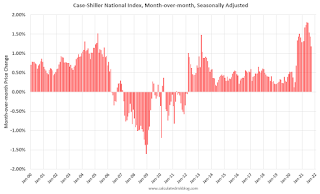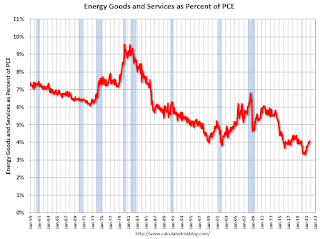by Calculated Risk on 11/30/2021 04:11:00 PM
Tuesday, November 30, 2021
Fannie Mae: Mortgage Serious Delinquency Rate Decreased in October
Fannie Mae reported that the Single-Family Serious Delinquency decreased to 1.46% in October, from 1.62% in September. The serious delinquency rate is down from 3.05% in October 2020.
These are mortgage loans that are "three monthly payments or more past due or in foreclosure".
The Fannie Mae serious delinquency rate peaked in February 2010 at 5.59% following the housing bubble, and peaked at 3.32% in August 2020 during the pandemic.
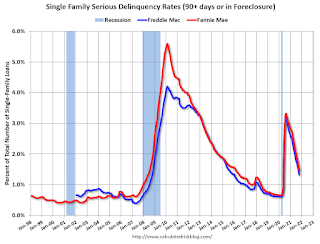
By vintage, for loans made in 2004 or earlier (1% of portfolio), 4.02% are seriously delinquent (down from 4.25% in September). For loans made in 2005 through 2008 (2% of portfolio), 6.90% are seriously delinquent (down from 7.21%), For recent loans, originated in 2009 through 2021 (97% of portfolio), 1.17% are seriously delinquent (down from 1.31%). So, Fannie is still working through a few poor performing loans from the bubble years.
Mortgages in forbearance are counted as delinquent in this monthly report, but they will not be reported to the credit bureaus.
This is very different from the increase in delinquencies following the housing bubble. Lending standards have been fairly solid over the last decade, and most of these homeowners have equity in their homes - and they will be able to restructure their loans once they are employed.
Freddie Mac reported earlier.
Las Vegas Visitor Authority for October: Visitor Traffic Down 7.6% Compared to 2019
by Calculated Risk on 11/30/2021 02:31:00 PM
From the Las Vegas Visitor Authority: October 2021 Las Vegas Visitor Statistics
With significant events and an improving convention segment, October saw the strongest visitation of the pandemic era both on weekends and midweek as the destination welcomed nearly 3.4M visitors (up 15.5% MoM and down ‐7.6% from Oct 2019).
Hotel occupancy reached 81.6% for the month (up 8.6 pts MoM, down ‐8.4 pts vs. Oct 2019), as Weekend occupancy reached 90.4% (up 1.3 pts MoM) while Midweek occupancy improved from the prior month to 77.5% (up 11.4 pts MoM).
October room rates approached $174, significantly ahead of last month and Oct 2019 (up 11.5% MoM and up 28.3% vs. Oct 2019) while RevPAR neared $142, up 24.6% MoM and 16.4% ahead of Oct 2019.
 Click on graph for larger image.
Click on graph for larger image. Thist graph shows visitor traffic for 2019 (blue), 2020 (orange) and 2021 (red).
Visitor traffic was down 7.6% compared to the same month in 2019.
FDIC: Problem Banks Declined, Residential REO Declined in Q3
by Calculated Risk on 11/30/2021 12:41:00 PM
The FDIC released the Quarterly Banking Profile for Q3 2021 this morning:
Quarterly net income rose $18.4 billion (35.9 percent) to $69.5 billion from the same period one year ago.
...
Total assets increased $462.6 billion (2 percent) from second quarter 2021 to $23.3 trillion. Securities rose $225 billion (3.9 percent), while cash and balances due from depository institutions rose $126.8 billion (3.6 percent). Growth in mortgage-backed securities (up $101.9 billion, or 3 percent) and U.S. Treasury securities (up $99.3 billion, or 8.5 percent) continued to drive quarterly increases in total securities. Loans and securities with maturities longer than 5 years now make up almost a third (31.3 percent) of total assets, up from 28 percent in fourth quarter 2019.
Loans that were 90 days or more past due or in nonaccrual status (i.e., noncurrent loans) continued to decline (down $13.2 billion, or 10.8 percent) from first quarter 2021. The noncurrent rate for total loans declined 12 basis points from the previous quarter to 1.01 percent. Net charge-offs also continued to decline (down $8.3 billion, or 53.2 percent) from a year ago. The total net charge-off rate dropped 30 basis points to 0.27 percent—the lowest level on record.
emphasis added
 Click on graph for larger image.
Click on graph for larger image.The FDIC reported the number of problem banks declined to 46.
The number of FDIC-insured institutions declined from 4,951 in second quarter 2021 to 4,914. During third quarter 2021, three new banks opened, 39 institutions merged with other FDIC-insured institutions, one bank ceased operations, and no banks failed. The number of banks on the FDIC’s “Problem Bank List” declined by ten from second quarter to 46, the lowest level since QBP data collection began in 1984. Total assets of problem banks increased $4.8 billion (10.5 percent) from second quarter to $50.6 billion.This graph from the FDIC shows the number of problem banks and assets at 51 institutions.
Note: The number of assets for problem banks increased significantly back in 2018 when Deutsche Bank Trust Company Americas was added to the list (it must still be on the list given the assets of problem banks).
 The dollar value of 1-4 family residential Real Estate Owned (REOs, foreclosure houses) declined from $1.37 billion in Q3 2020 to $0.79 billion in Q3 2021. This is the lowest level of REOs in many years. (Probably declined sharply due to foreclosure moratoriums, forbearance programs and house price increases).
The dollar value of 1-4 family residential Real Estate Owned (REOs, foreclosure houses) declined from $1.37 billion in Q3 2020 to $0.79 billion in Q3 2021. This is the lowest level of REOs in many years. (Probably declined sharply due to foreclosure moratoriums, forbearance programs and house price increases).This graph shows the nominal dollar value of Residential REO for FDIC insured institutions. Note: The FDIC reports the dollar value and not the total number of REOs.
More on Case-Shiller and FHFA House Price Increases
by Calculated Risk on 11/30/2021 11:08:00 AM
Today, in the Newsletter: Case-Shiller National Index up 19.5% Year-over-year in September
Excerpt:
Both the Case-Shiller House Price Index (HPI) and the Federal Housing Finance Agency (FHFA) HPI for September were released today. Here is a graph of the month-over-month (MoM) change in the Case-Shiller National Index Seasonally Adjusted (SA).
The MoM increase in Case-Shiller was at 1.18%; still historically high, but lower than the previous 13 months. House prices started increasing sharply in the Case-Shiller index in August 2020, so the last 14 months have all been historically very strong, but the peak MoM growth is behind us - and the year-over-price growth is starting to decelerate.
...
As I discussed in How Much will the Fannie & Freddie Conforming Loan Limit Increase for 2022?, the FHFA HPI is used to determine the increase in the Conforming Loan Limit. The relevant quarterly index, the Expanded-Data Indexes (Estimated using Enterprise, FHA, and Real Property County Recorder Data Licensed from DataQuick for sales below the annual loan limit ceiling), was released this morning, and it was up 18.04% YoY. The actual 2022 CLL will be released later.
emphasis added
Case-Shiller: National House Price Index increased 19.5% year-over-year in September
by Calculated Risk on 11/30/2021 09:14:00 AM
S&P/Case-Shiller released the monthly Home Price Indices for September ("September" is a 3-month average of July, August and September prices).
This release includes prices for 20 individual cities, two composite indices (for 10 cities and 20 cities) and the monthly National index.
From S&P: S&P Corelogic Case-Shiller Index Reports 19.5% Annual Home Price Gain in September
The S&P CoreLogic Case-Shiller U.S. National Home Price NSA Index, covering all nine U.S. census divisions, reported a 19.5% annual gain in September, down from 19.8% in the previous month. The 10-City Composite annual increase came in at 17.8%, down from 18.6% in the previous month. The 20- City Composite posted a 19.1% year-over-year gain, down from 19.6% in the previous month.
Phoenix, Tampa, and Miami reported the highest year-over-year gains among the 20 cities in September. Phoenix led the way with a 33.1% year-over-year price increase, followed by Tampa with a 27.7% increase and Miami with a 25.2% increase. Six of the 20 cities reported higher price increases in the year ending September 2021 versus the year ending August 2021.
...
Before seasonal adjustment, the U.S. National Index posted a 1.0% month-over-month increase in September, while the 10-City and 20-City Composites both posted increases of 0.7% and 0.8%, respectively.
After seasonal adjustment, the U.S. National Index posted a month-over-month increase of 1.2%, and the 10-City and 20-City Composites both posted increases of 0.8% and 1.0%, respectively. In September, 19 of the 20 cities reported increases before seasonal adjustments while all 20 cities reported increases after seasonal adjustments.
“If I had to choose only one word to describe September 2021’s housing price data, the word would be ‘deceleration,’ says Craig J. Lazzara, Managing Director at S&P DJI. “Housing prices continued to show remarkable strength in September, though the pace of price increases declined slightly.The National Composite Index rose 19.5% from year-ago levels, with the 10- and 20-City Composites up 17.8% and 19.1%, respectively. This month, however, the rate of price growth began to decline, as each of our three composites rose less in September than in August.
...
“We have previously suggested that the strength in the U.S. housing market is being driven by households’ reaction to the COVID pandemic, as potential buyers move from urban apartments to suburban homes. More data will be required to understand whether this demand surge represents simply an acceleration of purchases that would have occurred over the next several years, or reflects a secular change in locational preferences. September’s report is consistent with either explanation.”
emphasis added
 Click on graph for larger image.
Click on graph for larger image. The first graph shows the nominal seasonally adjusted Composite 10, Composite 20 and National indices (the Composite 20 was started in January 2000).
The Composite 10 index is up 0.8% in September (SA).
The Composite 20 index is up 1.0% (SA) in September.
The National index is 46% above the bubble peak (SA), and up 1.2% (SA) in September. The National index is up 98% from the post-bubble low set in February 2012 (SA).
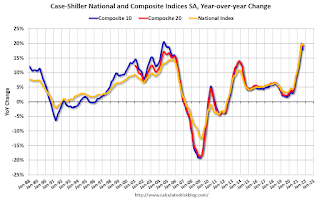 The second graph shows the year-over-year change in all three indices.
The second graph shows the year-over-year change in all three indices.The Composite 10 SA is up 17.8% year-over-year. The Composite 20 SA is up 19.1% year-over-year.
The National index SA is up 19.5% year-over-year.
Price increases were slightly below expectations. I'll have more later.
Monday, November 29, 2021
Tuesday: Case-Shiller House Prices, FHFA Conforming Loan Limits, Fed Chair Powell Testimony and More
by Calculated Risk on 11/29/2021 09:02:00 PM
From Matthew Graham at Mortgage News Daily: MBS RECAP: Bonds Find Footing After Shaky Start
This morning we found ourselves in the uncomfortable position of watching the bond market backtrack on massive gains at the end of the previous week. This is always a risk when the market goes on a big run--especially on a Friday. But rather than continue to erase Friday's gains, bonds found their footing in the 10am hour as a part of a broader "risk-off" move. [30 year fixed 3.21%]Tuesday:
emphasis added
• At 9:00 AM ET, FHFA House Price Index for September. This was originally a GSE only repeat sales, however there is also an expanded index. The 2022 Conforming loan limits will also be announced.
• At 9:00 AM, S&P/Case-Shiller House Price Index for September. The consensus is for a 19.3% year-over-year increase in the Composite 20 index for September.
• At 9:45 AM, Chicago Purchasing Managers Index for November.
• At 10:00 AM, Testimony, Fed Chair Jerome Powell, Coronavirus and CARES Act, Before the U.S. Senate Committee on Banking, Housing, and Urban Affairs
• At 10:30 AM, FDIC Quarterly Banking Profile, Third quarter.
November 29th COVID-19: Holiday Impacted Data
by Calculated Risk on 11/29/2021 08:41:00 PM
| COVID Metrics | ||||
|---|---|---|---|---|
| Today | Week Ago | Goal | ||
| Percent fully Vaccinated | 59.3% | --- | ≥70.0%1 | |
| Fully Vaccinated (millions) | 196.8 | --- | ≥2321 | |
| New Cases per Day3 | 72,008 | 91,497 | ≤5,0002 | |
| Hospitalized3 | 41,442 | 42,596 | ≤3,0002 | |
| Deaths per Day3 | 719 | 962 | ≤502 | |
| 1 Minimum to achieve "herd immunity" (estimated between 70% and 85%). 2my goals to stop daily posts, 37-day average for Cases, Currently Hospitalized, and Deaths 🚩 Increasing 7-day average week-over-week for Cases, Hospitalized, and Deaths ✅ Goal met. | ||||
IMPORTANT: For "herd immunity" most experts believe we need 70% to 85% of the total population fully vaccinated (or already had COVID). Note: COVID will probably stay endemic (at least for some time).
The following 19 states have between 50% and 59.9% fully vaccinated: Wisconsin at 59.5%, Nebraska, Iowa, Utah, Michigan, Texas, Kansas, Arizona, Nevada, South Dakota, North Carolina, Alaska, Ohio, Kentucky, Montana, Oklahoma, South Carolina, Missouri and Indiana at 50.6%.
Next up (total population, fully vaccinated according to CDC) are Tennessee at 49.5%, Georgia at 49.4%, Arkansas at 49.3%, Louisiana at 48.9% and North Dakota at 48.7%.
 Click on graph for larger image.
Click on graph for larger image.This graph shows the daily (columns) and 7-day average (line) of positive tests reported.
2022 Housing Forecasts
by Calculated Risk on 11/29/2021 06:33:00 PM
Today, in the Newsletter: 2022 Housing Forecasts: Second Look
Excerpt:
The key in 2022 will be inventory. If inventory stays extremely low, there will be more housing starts and a larger increase in prices. However, if inventory increases significantly, there will be fewer starts and less price appreciation. Towards the end of each year, I collect some housing forecasts for the following year.
...
For house prices, there is a very wide spread. As of August, Case-Shiller house prices were up 19.8% year-over-year.
emphasis added
Fed Chair Powell: "Factors pushing inflation upward will linger well into next year"
by Calculated Risk on 11/29/2021 04:42:00 PM
From Fed Chair Powell's prepared testimony: Coronavirus and CARES Act, Excerpt on inflation:
Most forecasters, including at the Fed, continue to expect that inflation will move down significantly over the next year as supply and demand imbalances abate. It is difficult to predict the persistence and effects of supply constraints, but it now appears that factors pushing inflation upward will linger well into next year. In addition, with the rapid improvement in the labor market, slack is diminishing, and wages are rising at a brisk pace.And on the new COVID variant:
emphasis added
The recent rise in COVID-19 cases and the emergence of the Omicron variant pose downside risks to employment and economic activity and increased uncertainty for inflation. Greater concerns about the virus could reduce people's willingness to work in person, which would slow progress in the labor market and intensify supply-chain disruptions.Powell will provide his testimony tomorrow at 10AM ET: Coronavirus and CARES Act, Before the U.S. Senate Committee on Banking, Housing, and Urban Affairs
Black Knight: Number of Mortgages in Forbearance Increased Slightly
by Calculated Risk on 11/29/2021 01:10:00 PM
This data is as of November 23rd.
From Andy Walden at Black Knight: November Forbearance Exits Steady Heading Into Thanksgiving
Active forbearance plan numbers remained relatively steady heading into the Thanksgiving holiday, holding true to the established mid-month pattern.
According to our McDash Flash daily forbearance tracking dataset, the number of active forbearance plans increased by 1,000 this week. A decline among FHA/VA loans (-4,000) was offset by another 5,000 rise in plan volumes among portfolio and PLS mortgages as GSE plans held steady. Both plan extensions and renewals remained steady, but low, in keeping with the typical mid-month lull.br />
As of November 23, 1.01 million mortgage holders (1.9%) of mortgage holders, remain in COVID-19 related forbearance plans, including 1.2% of GSE, 3.0% of FHA/VA and 2.5% of portfolio held and privately securitized loans.
Click on graph for larger image.
Overall, the number of forbearance plans is still down by 214,000 (-17%) from the same time last month, with the potential for additional improvements as we enter December. New plan starts, which have been relatively flat since the end of March, jumped almost 8,000 week over week, a number that will bear closer scrutiny in coming weeks to determine whether this is an anomaly or an inflection point.
emphasis added
Housing Inventory Nov 29th Update: Inventory Down 2.6% Week-over-week
by Calculated Risk on 11/29/2021 11:09:00 AM
Tracking existing home inventory is very important this year and in 2022.
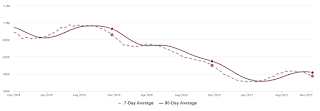
This inventory graph is courtesy of Altos Research.
NAR: Pending Home Sales Increased 7.5% in October
by Calculated Risk on 11/29/2021 10:04:00 AM
From the NAR: Pending Home Sales Jump 7.5% in October
Pending home sales increased in October, rebounding after a decline the month prior, according to the National Association of Realtors®. Contract activity rose month-over-month in each of the four major U.S. regions. On a year-over-year basis, however, transactions were split, as two regions reported drops and two others posted gains.This was well above expectations of a 1.0% increase for this index. Note: Contract signings usually lead sales by about 45 to 60 days, so this would usually be for closed sales in November and December.
The Pending Home Sales Index (PHSI), a forward-looking indicator of home sales based on contract signings, rose 7.5% to 125.2 in October. Year-over-year, signings fell 1.4%. An index of 100 is equal to the level of contract activity in 2001.
...
Compared to the previous month, contract signings rose at the strongest pace in the Midwest and South regions. Month-over-month, the Northeast PHSI increased 6.9% to 99.5 in October, a 10% drop from a year ago. In the Midwest, the index climbed 11.8% to 124.6 last month, up 5.1% from October 2020.
Pending home sales transactions in the South rose 8.0% to an index of 149.7 in October, up 0.6% from October 2020. The index in the West grew 2.1% in October to 107.5, down 6.2% from a year prior.
emphasis added
Seven High Frequency Indicators for the Economy
by Calculated Risk on 11/29/2021 08:16:00 AM
These indicators are mostly for travel and entertainment. It is interesting to watch these sectors recover as the pandemic subsides.
The TSA is providing daily travel numbers.
This data is as of November 28th.
 Click on graph for larger image.
Click on graph for larger image.This data shows the 7-day average of daily total traveler throughput from the TSA for 2019 (Light Blue), 2020 (Blue) and 2021 (Red).
The dashed line is the percent of 2019 for the seven-day average.
The 7-day average is down 12.1% from the same day in 2019 (87.9% of 2019). (Dashed line)
The second graph shows the 7-day average of the year-over-year change in diners as tabulated by OpenTable for the US and several selected cities.
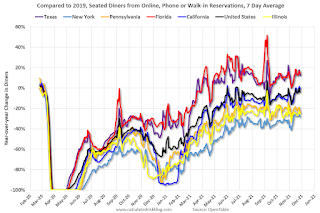 Thanks to OpenTable for providing this restaurant data:
Thanks to OpenTable for providing this restaurant data:This data is updated through November 27, 2021.
This data is "a sample of restaurants on the OpenTable network across all channels: online reservations, phone reservations, and walk-ins. For year-over-year comparisons by day, we compare to the same day of the week from the same week in the previous year."
Note that this data is for "only the restaurants that have chosen to reopen in a given market". Since some restaurants have not reopened, the actual year-over-year decline is worse than shown.
Dining picked up for the Labor Day weekend, but declined after the holiday - and is mostly moving sideways. The 7-day average for the US is down 4% compared to 2019.
 This data shows domestic box office for each week and the median for the years 2016 through 2019 (dashed light blue).
This data shows domestic box office for each week and the median for the years 2016 through 2019 (dashed light blue). Note that the data is usually noisy week-to-week and depends on when blockbusters are released.
Movie ticket sales were at $127 million last week, down about 53% from the median for the week.
 This graph shows the seasonal pattern for the hotel occupancy rate using the four week average.
This graph shows the seasonal pattern for the hotel occupancy rate using the four week average. The red line is for 2021, black is 2020, blue is the median, dashed purple is 2019, and dashed light blue is for 2009 (the worst year on record for hotels prior to 2020).
This data is through November 13th. The occupancy rate was down 4.0% compared to the same week in 2019.
Notes: Y-axis doesn't start at zero to better show the seasonal change.
 This graph, based on weekly data from the U.S. Energy Information Administration (EIA), shows gasoline supplied compared to the same week of 2019.
This graph, based on weekly data from the U.S. Energy Information Administration (EIA), shows gasoline supplied compared to the same week of 2019.Blue is for 2020. Red is for 2021.
As of November 19th, gasoline supplied was up 1.4% compared to the same week in 2019.
There was the tenth week this year that gasoline supplied was up compared to the same week in 2019 - so consumption is running close to 2019 levels now.
This graph is from Apple mobility. From Apple: "This data is generated by counting the number of requests made to Apple Maps for directions in select countries/regions, sub-regions, and cities." This is just a general guide - people that regularly commute probably don't ask for directions.
There is also some great data on mobility from the Dallas Fed Mobility and Engagement Index. However the index is set "relative to its weekday-specific average over January–February", and is not seasonally adjusted, so we can't tell if an increase in mobility is due to recovery or just the normal increase in the Spring and Summer.
 This data is through November 24th
This data is through November 24th The graph is the running 7-day average to remove the impact of weekends.
IMPORTANT: All data is relative to January 13, 2020. This data is NOT Seasonally Adjusted. People walk and drive more when the weather is nice, so I'm just using the transit data.
According to the Apple data directions requests, public transit in the 7-day average for the US is at 114% of the January 2020 level.
Here is some interesting data on New York subway usage (HT BR).
 This graph is from Todd W Schneider.
This graph is from Todd W Schneider. This data is through Friday, November 26th.
He notes: "Data updates weekly from the MTA’s public turnstile data, usually on Saturday mornings".
Sunday, November 28, 2021
Monday: Pending Home Sales
by Calculated Risk on 11/28/2021 06:41:00 PM
Weekend:
• Schedule for Week of November 28, 2021
Monday:
• At 10:00 AM ET, Pending Home Sales Index for October. The consensus is for a 1.0% increase in the index.
• At 10:30 AM, Dallas Fed Survey of Manufacturing Activity for November. This is the last of the regional Fed manufacturing surveys for November.
From CNBC: Pre-Market Data and Bloomberg futures S&P 500 futures are up 31 and DOW futures are up 180 (fair value).
Oil prices were down over the last week with WTI futures at $70.30 per barrel and Brent at $74.67 per barrel. A year ago, WTI was at $46, and Brent was at $47 - so WTI oil prices are up 50% year-over-year.
Here is a graph from Gasbuddy.com for nationwide gasoline prices. Nationally prices are at $3.38 per gallon. A year ago prices were at $2.11 per gallon, so gasoline prices are up $1.27 per gallon year-over-year.
Philly Fed: State Coincident Indexes Increased in 48 States in October
by Calculated Risk on 11/28/2021 12:01:00 PM
From the Philly Fed:
The Federal Reserve Bank of Philadelphia has released the coincident indexes for the 50 states for October 2021. Over the past three months, the indexes increased in 49 states and decreased in one state, for a three-month diffusion index of 96. Additionally, in the past month, the indexes increased in 48 states and decreased in two states, for a one-month diffusion index of 92. For comparison purposes, the Philadelphia Fed has also developed a similar coincident index for the entire United States. The Philadelphia Fed’s U.S. index increased 1.4 percent over the past three months and 0.4 percent in October.Note: These are coincident indexes constructed from state employment data. An explanation from the Philly Fed:
emphasis added
The coincident indexes combine four state-level indicators to summarize current economic conditions in a single statistic. The four state-level variables in each coincident index are nonfarm payroll employment, average hours worked in manufacturing by production workers, the unemployment rate, and wage and salary disbursements deflated by the consumer price index (U.S. city average). The trend for each state’s index is set to the trend of its gross domestic product (GDP), so long-term growth in the state’s index matches long-term growth in its GDP.
 Click on map for larger image.
Click on map for larger image.Here is a map of the three month change in the Philly Fed state coincident indicators. This map was all red during the worst of the Pandemic and also at the worst of the Great Recession.
The map is almost all positive on a three-month basis.
Source: Philly Fed.
 And here is a graph is of the number of states with one month increasing activity according to the Philly Fed.
And here is a graph is of the number of states with one month increasing activity according to the Philly Fed. In October, 48 states had increasing activity including minor increases.
Saturday, November 27, 2021
Real Estate Newsletter Articles this Week
by Calculated Risk on 11/27/2021 02:11:00 PM
At the Calculated Risk Real Estate Newsletter this week:
• Four House Price Topics Case-Shiller and the FHFA Indexes will be released on Tuesday
• New Home Sales: Record 109 thousand homes have not been started Prices Are Up Sharply Year-over-year
• Final Look: Local Housing Markets in October No Sign of a Slowing Market
• Existing-Home Sales Increased to 6.34 million in October
This is usually published several times a week, and provides more in-depth analysis of the housing market.
You can subscribe at https://calculatedrisk.substack.com/ Currently all content is available for free - and some will always be free - but please subscribe!.
Schedule for Week of November 28, 2021
by Calculated Risk on 11/27/2021 08:11:00 AM
The key report this week is the November employment report on Friday.
Other key indicators include the September Case-Shiller house price index, the November ISM manufacturing and services indexes, and November vehicle sales.
10:00 AM: Pending Home Sales Index for October. The consensus is for a 1.0% increase in the index.
10:30 AM: Dallas Fed Survey of Manufacturing Activity for November. This is the last of the regional Fed manufacturing surveys for November.
9:00 AM: FHFA House Price Index for September. This was originally a GSE only repeat sales, however there is also an expanded index. The 2022 Conforming loan limits will also be announced.
 9:00 AM ET: S&P/Case-Shiller House Price Index for September.
9:00 AM ET: S&P/Case-Shiller House Price Index for September.This graph shows graph shows the Year over year change in the seasonally adjusted National Index, Composite 10 and Composite 20 indexes through the most recent report (the Composite 20 was started in January 2000).
The consensus is for a 19.3% year-over-year increase in the Composite 20 index for September.
9:45 AM: Chicago Purchasing Managers Index for November.
10:00 AM: Testimony, Fed Chair Jerome Powell, Coronavirus and CARES Act, Before the U.S. Senate Committee on Banking, Housing, and Urban Affairs
10:30 AM: FDIC Quarterly Banking Profile, Third quarter.
7:00 AM ET: The Mortgage Bankers Association (MBA) will release the results for the mortgage purchase applications index.
8:15 AM: The ADP Employment Report for November. This report is for private payrolls only (no government). The consensus is for 525,000 jobs added, down from 571,000 in October.
10:00 AM: ISM Manufacturing Index for November. The consensus is for 61.0%, up from 60.8%.
10:00 AM: Construction Spending for October. The consensus is for 0.4% increase in spending.
2:00 PM: the Federal Reserve Beige Book, an informal review by the Federal Reserve Banks of current economic conditions in their Districts.
 All day: Light vehicle sales for November.
All day: Light vehicle sales for November.The consensus is for 13.2 million SAAR in November, up from the BEA estimate of 13.0 million SAAR in October (Seasonally Adjusted Annual Rate).
This graph shows light vehicle sales since the BEA started keeping data in 1967. The dashed line is the current sales rate.
8:30 AM: The initial weekly unemployment claims report will be released. The consensus is for 250 thousand initial claims, up from 199 thousand last week.
 8:30 AM: Employment Report for November. The consensus is for 563 thousand jobs added, and for the unemployment rate to decrease to 4.5%.
8:30 AM: Employment Report for November. The consensus is for 563 thousand jobs added, and for the unemployment rate to decrease to 4.5%.There were 531 thousand jobs added in October, and the unemployment rate was at 4.6%.
This graph shows the job losses from the start of the employment recession, in percentage terms.
The current employment recession was by far the worst recession since WWII in percentage terms, but currently is not as severe as the "Great Recession".
10:00 AM: the ISM Services Index for November.
Friday, November 26, 2021
Energy expenditures as a percentage of PCE
by Calculated Risk on 11/26/2021 02:11:00 PM
Note: Back in early 2016, I noted that energy expenditures as a percentage of PCE had hit an all-time low. Here is an update through the recently released October PCE report.
Below is a graph of expenditures on energy goods and services as a percent of total personal consumption expenditures through October 2021.
This is one of the measures that Professor Hamilton at Econbrowser looks at to evaluate any drag on GDP from energy prices.
Click on graph for larger image.
Data source: BEA.
The huge spikes in energy prices during the oil crisis of 1973 and 1979 are obvious. As is the increase in energy prices during the 2001 through 2008 period.
In general, energy expenditures as a percent of PCE have been trending down for years.
At the beginning of the pandemic, energy expenditures as a percentage of PCE, fell to a record low of 3.3% in May 2020.
Four House Price Topics
by Calculated Risk on 11/26/2021 10:27:00 AM
Today, in the Real Estate Newsletter: Four House Price Topics
Brief excerpt:
Even though the September index will show another very strong YoY gain, I expect house price growth to decelerate in coming months.You can subscribe at https://calculatedrisk.substack.com/ (Currently all content is available for free, but please subscribe).
...
The following graph shows YoY price changes for the NAR median house prices, Case-Shiller National price index, and the FHFA purchase-only index (Fannie and Freddie loans only).
Most of the time, the NAR median price leads the Case-Shiller index, and I expect the Case-Shiller index to show a lower growth rate (but still robust) in coming months.
...
In the October existing home sales report released last week, the NAR reported months-of-supply was unchanged at 2.4 months in October. There is a seasonal pattern to inventory, but this is still very low - and prices will remain solid as long as inventories stay low.
Q4 GDP Forecasts: Moving Up
by Calculated Risk on 11/26/2021 08:06:00 AM
These forecasts are prior to the news on the B.1.1.529 variant: Heavily mutated coronavirus variant puts scientists on alert
Goldman Sachs also put out a note prior to the variant news:
“We now expect the Fed to announce at its December meeting that it is doubling the pace of tapering to $30bn per month starting in January. ... While this faster pace of tapering would allow the FOMC to consider a rate hike as early as March, our best guess is that it will wait until June, when a few additional employment reports will be available. We now expect hikes in June, September, and December …”From BofA:
4Q GDP tracking remains at 6.0% qoq saar, supported by the strong data this week. [November 24 estimate]From Goldman Sachs
emphasis added
We boosted our Q4 GDP tracking estimate by 1pt to +6.0% (qoq ar). This change embeds larger expected contributions from inventories and goods exports, and it also reflects the strong Q3 pace of gross domestic income (+6.7% annualized). [November 24 estimate]And from the Altanta Fed: GDPNow
The GDPNow model estimate for real GDP growth (seasonally adjusted annual rate) in the fourth quarter of 2021 is 8.6 percent on November 24, up from 8.2 percent on November 17. [November 24 estimate]

